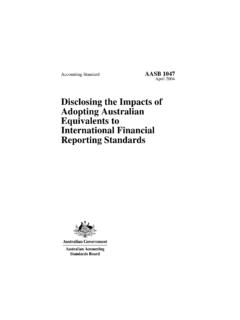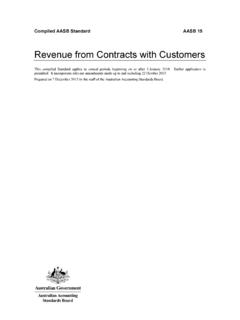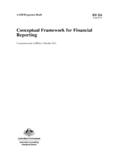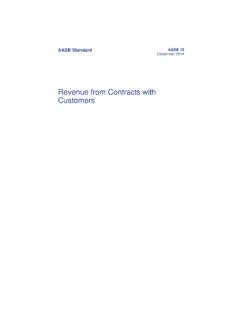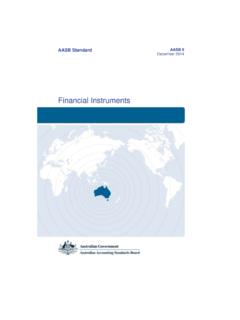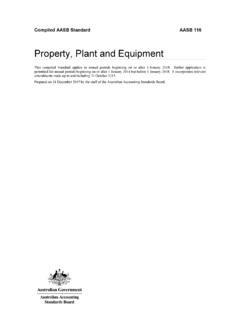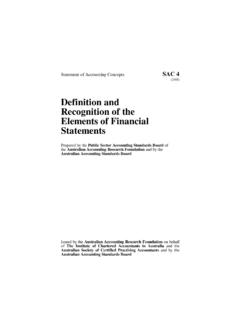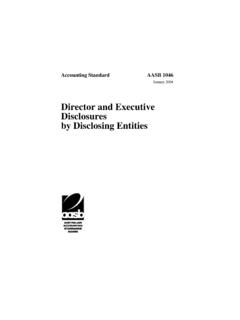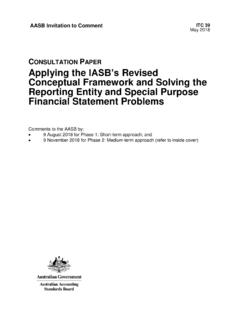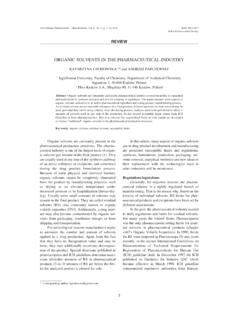Transcription of Proposed Amendments to Provisions, Contingent …
1 exposure draft ED 140. July 2005. Proposed Amendments to AASB 137 provisions , Contingent liabilities and Contingent Assets and AASB 119 Employee Benefits Prepared by the Australian Accounting Standards Board Commenting on this exposure draft Constituents are strongly encouraged to respond to the AASB and the IASB. The AASB is seeking comment by 23 September 2005. This will enable the AASB to consider Australian constituents' comments in the process of formulating its own comments to the IASB, which are due by 28 October 2005. Comments should be addressed to: The Chairman Henry Rees Australian Accounting Standards Board Project Manager PO Box 204 International Accounting Standards Board Collins St West Vic 8007 30 Cannon Street AUSTRALIA London EC4M 6XH. E-mail: UNITED KINGDOM. E-mail: A copy of all non-confidential submissions to the AASB will be placed on public record on the AASB's website: Obtaining a Copy of this exposure draft This exposure draft is available on the AASB's website: Alternatively, printed copies of this exposure draft are available by contacting: The Customer Service Officer Phone: (03) 9617 7637.
2 Australian Accounting Standards Board Fax: (03) 9617 7608. Level 4 E-mail: 530 Collins Street Postal address: Melbourne Victoria PO Box 204. AUSTRALIA Collins St West Vic 8007. Other Enquiries Phone: (03) 9617 7600. Fax: (03) 9617 7608. E-mail: COPYRIGHT. 2005 Australian Accounting Standards Board (AASB). The text, graphics and layout of this exposure draft are protected by Australian copyright law and the comparable law of other countries. The exposure draft may be reproduced in print for the sole purpose of preparing a written submission to the AASB and/or the IASB in respect of the exposure draft . Otherwise, no part of the exposure draft may be reproduced, stored or transmitted in any form or by any means without the prior written permission of the AASB except as permitted by law. ISSN 1030-5882. ED 140 ii COPYRIGHT. CONTENTS. PREFACE. IASB exposure draft of Proposed Amendments to IAS 37 provisions , Contingent liabilities and Contingent Assets and IAS 19 Employee Benefits The IASB ED comprises a clean copy of IAS 37 and a marked up copy of IAS 19, including Bases for Conclusions and Illustrative Examples.
3 A mark-up of the Proposed changes to IAS 37 is available on the AASB website ( ). The AASB intends to retain the application and materiality paragraphs (as per the existing AASB 137) in the revised AASB 137. The AASB also intends to review the Australian Guidance on self-insurance arrangements and captive insurers that accompanies the existing AASB 137 in light of the Proposed Amendments . ED 140 iii CONTENTS. PREFACE. Background Australian Accounting Standards The Australian Accounting Standards Board (AASB) makes Australian Accounting Standards to be applied by: (a) entities required by the Corporation Act 2001 to prepare financial reports;. (b) all reporting entities engaged in either for-profit, not-for-profit or public sectors; and (c) any other entity that prepares general purpose financial reports. Australian Accounting Standards that apply to annual reporting periods beginning on or after 1 January 2005 include Australian equivalents to International Financial Reporting Standards (IFRSs).
4 IFRSs comprise accounting standards and interpretations. IFRSs are issued by the International Accounting Standards Board (IASB), and their adoption in Australia is in accordance with a strategic directive made by the Financial Reporting Council. The reasons for adoption of IFRSs in Australia are explained in CLERP Paper No. 9: Proposals for Reform Corporate Disclosure (2002). Although IFRSs are developed to apply to for-profit entities, the AASB has decided to continue to make sector-neutral accounting standards. Accordingly, Australian Accounting Standards (including Australian equivalents to IFRSs) generally apply to both for-profit and not-for-profit entities, including public sector entities. An Australian equivalent to an IFRS. uses the corresponding IFRS as the foundation Standard to which the AASB adds material detailing its scope and applicability in the Australian environment.
5 Additions are made, where necessary, to broaden the content of the Australian equivalent to an IFRS to cover domestic, regulatory or other issues. In addition to making accounting standards that are Australian equivalents to IFRSs, the AASB also continues to make other Australian Accounting Standards that are specific to the not-for-profit or public sectors or that are purely of a domestic nature. exposure Drafts The adoption of IFRSs is an ongoing process. Whenever the IASB issues new or amended IFRSs, the AASB must also consider making new or amended Australian equivalents to those IFRSs. In developing a new or amended IFRS, the IASB releases an exposure draft (ED) of the Proposed Standard or Amendments for public comment. The AASB generally follows a similar due process prior to making or amending Australian Accounting Standards. In the case of changes Proposed by the IASB to IFRSs, the AASB also releases an ED containing those Proposed changes and specifically invites comments from Australian constituents on, among other things, whether the implementation of the proposals in an Australian equivalent to an IFRS may be affected by the Australian environment (including the legal and regulatory environment) and whether the proposals are in the best interests of the Australian economy.
6 Purpose of this exposure draft The purpose of this ED is to invite comments from Australian constituents on Proposed Amendments to AASB 137 provisions , Contingent liabilities and Contingent Assets and AASB 119 Employee Benefits, which are the Australian equivalents to IAS 37 provisions , Contingent liabilities and Contingent Assets and IAS 19 Employee Benefits. These Proposed Amendments are contained in the exposure draft of Proposed Amendments to IAS 37 provisions , Contingent liabilities and Contingent Assets and IAS 19 Employee ED 140 iv PREFACE. Benefits that was issued by the IASB on 30 June 2005. If these Amendments are approved by the IASB, and subsequently by the AASB, they are expected to be applicable to annual reporting periods beginning on or after 1 January 2007. Structure of this exposure draft The AASB has decided to: (a) reproduce the IASB exposure draft of Proposed Amendments to IAS 37 provisions , Contingent liabilities and Contingent Assets and IAS 19 Employee Benefits without amendment as part of this ED; and (b) identify the main changes and the AASB's preliminary views in this Preface.
7 To assist constituents in their assessment of the Proposed Amendments , this Preface provides comparative information and explanations, arranged in the following order. Application (application date, application and materiality paragraphs, implications for public sector entities). Summary of Main Changes to AASB 137. Summary of Main Changes to AASB 119. Request for Comments (including specific matters). A copy of all Australian Accounting Standards applicable to annual reporting periods beginning on or after 1 January 2005, including the existing AASB 137 provisions , Contingent liabilities and Contingent Assets and AASB 119 Employee Benefits, may be downloaded free of charge from the AASB website ( ). Application The proposals in the ED are intended to: (a) replace AASB 137, issued in July 2004;. (b) amend some of the requirements of AASB 119: (i) first issued in July 2004, with application to reporting periods beginning on or after 1 January 2005; or (ii) subsequently revised in December 2004, with application to reporting periods beginning on or after 1 January 2006 (unless early adopted); and (c) consequentially amend a number of other Australian Accounting Standards.
8 This ED. identifies the consequential Amendments to various Australian equivalents to IFRSs. The AASB is currently reviewing the consequential Amendments that would need to be made to domestic Australian Accounting Standards (including Interpretations of the Urgent Issues Group). Constituents will be advised of these consequential Amendments separately. The existing requirements of these Standards remain operative until superseded by the proposals in this ED. ED 140 v PREFACE. Application Date The AASB intends to make the revised AASB 137 and the Amendments to AASB 119 and other Standards applicable from the start of the first annual reporting period beginning on or after 1 January 2007. Earlier application is Proposed to be permitted for annual reporting periods beginning on or after the date the Amendments are made by the AASB. The restatement of comparative information when the Amendments are first applied is not being Proposed .
9 Application and Materiality Paragraphs The AASB intends to include the application and materiality paragraphs (as per the existing AASB 137) in the revised AASB 137. For the Amendments to AASB 119 and other Australian Accounting Standards, the application and materiality paragraphs in those Standards will continue to apply. Implications for Public Sector Entities No additional requirements or exemptions were included in the existing AASB 137 for either not-for-profit or public sector entities. Although for certain public sector entities, some guidance on the recognition of obligations to provide non-exchange social benefits is provided in other Australian Accounting Standards (see, specifically, AAS 31 Financial Reporting by Governments (paragraph ) and AAS 29 Financial Reporting by Government Departments (paragraph ), and more generally AAS 27 Financial Reporting by Local Governments).
10 As the AASB has recently decided to propose the withdrawal of AAS 27, AAS 29 and AAS 31 (refer AASB Action Alert, July 2005), the AASB will consider whether the specific guidance should be added to a revised AASB 137. In the longer term, it is anticipated that the AASB will revisit the accounting treatment of non-exchange social benefits following the outcomes of the work that the International Public Sector Accounting Standards Board is currently undertaking on social policy obligations. Summary of Main Changes to AASB 137. A summary of the main changes to AASB 137 and the AASB's preliminary views on these changes follows. Refer to the IASB ED, pages 14 to 18, for a summary of the main changes to IAS 37. Scope of AASB 137. AASB 137 defines a provision as a liability of uncertain timing or amount'. The ED does not use provision' as a defined term and instead proposes using the term non-financial liability' which includes items previously described as provisions as well as other non- financial liabilities .
